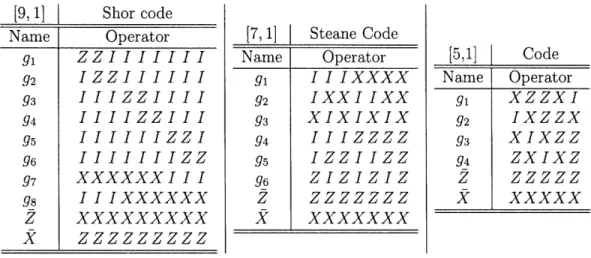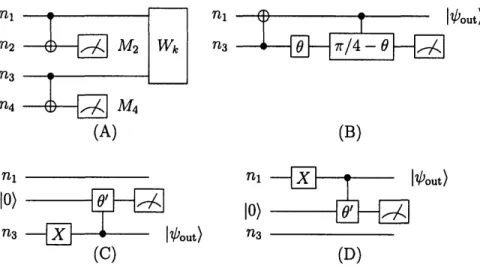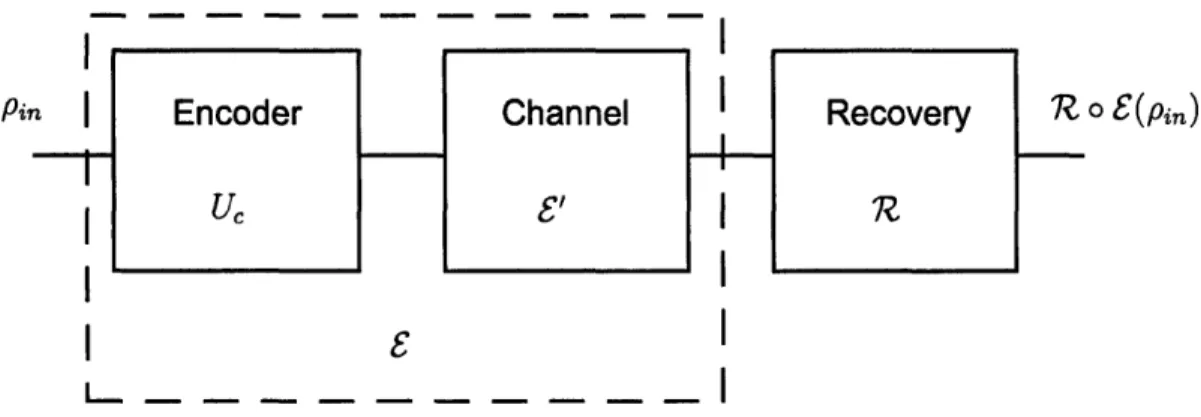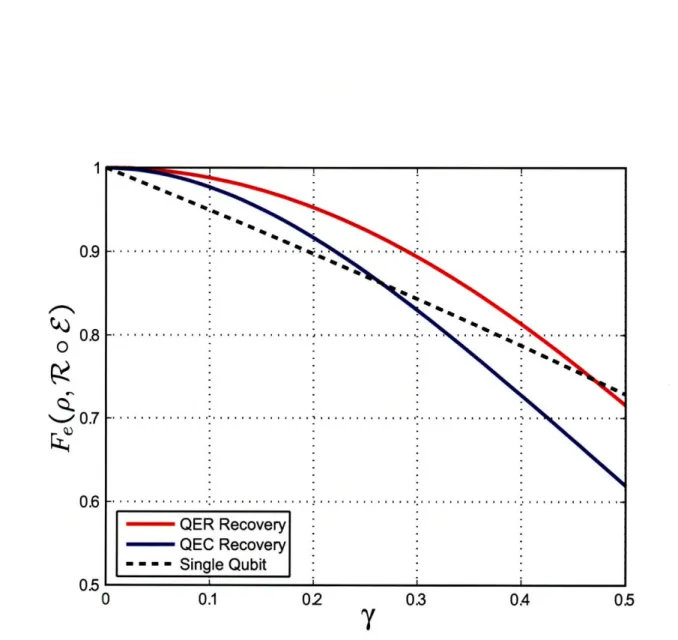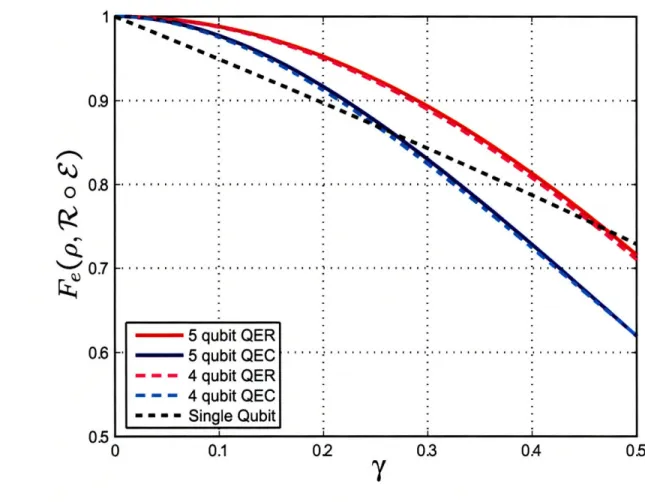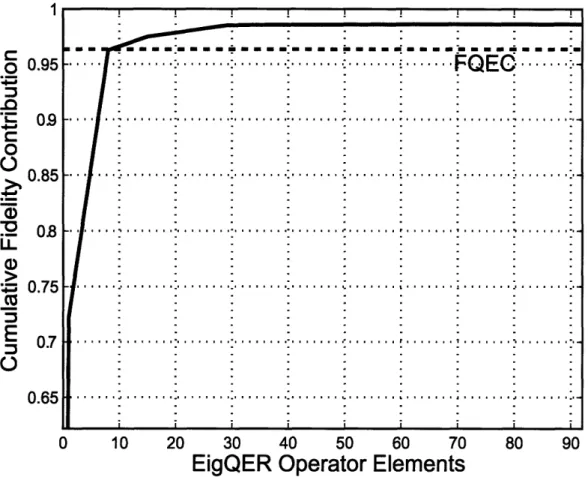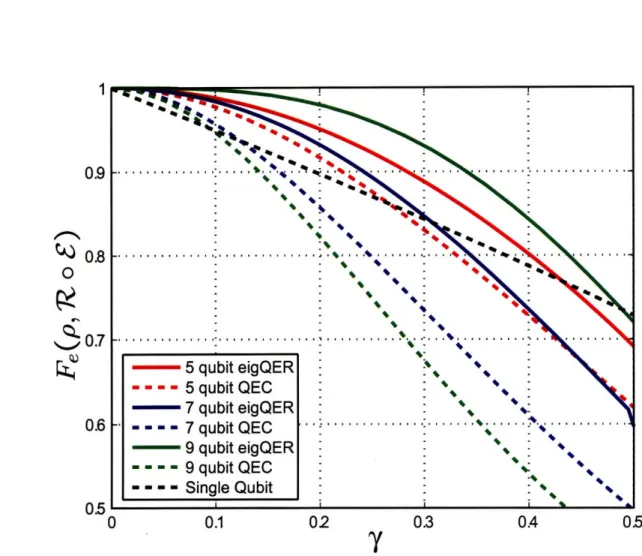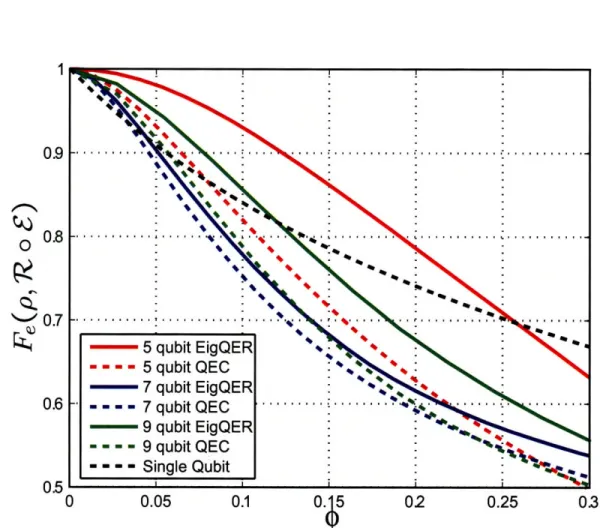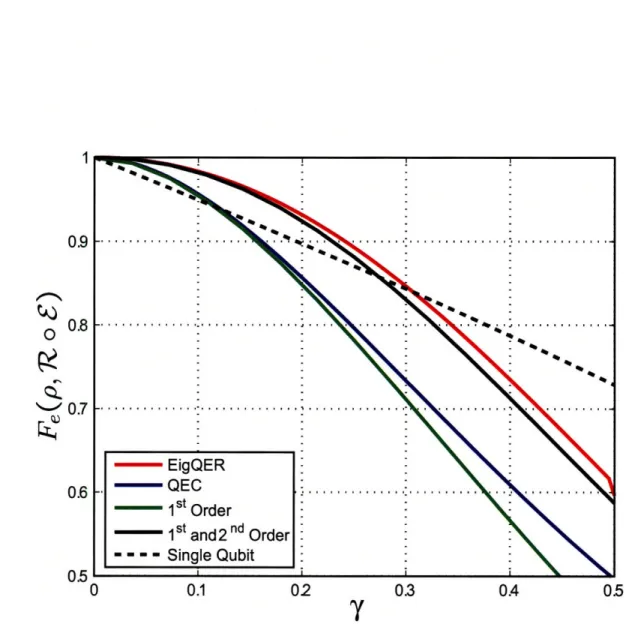Channel-Adapted Quantum Error Correction
by
Andrew Stephen Fletcher
Submitted to the Department of Electrical Engineering and Computer
Science
in partial fulfillment of the requirements for the degree of
Doctor of Philosophy
at the
MASSACHUSETTS INSTITUTE OF TECHNOLOGY
June 2007
@
Massachusetts Institute of Technology 2007. All rights reserved.
Author ... "•,
.
...
Department of Electrical Engineering and Computer Science
Z7
.0, .I
May 22, 2007
Certified by.
. .... . . . . .. . ... . . ... ... . . ... ... .Peter W. Shor
Morss Professor of Applied Mathematics
. . , A
Certified by...
Thesis Supervisor
Moe Z. Win
Associate Professor
Thesis Supervisor
• •JAccepted by
.... .
er. .- ' --.. .. . .. . ...Arthur C. Smith
Chairman, Department Committee on Graduate Students
MASSACHUSETS INST'ITUTEOF TECHNOLOGY
AUG 1
6
2007
LIBRARIES
Channel-Adapted Quantum Error Correction
by
Andrew Stephen Fletcher
Submitted to the Department of Electrical Engineering and Computer Science
on May 22, 2007, in partial fulfillment of the
requirements for the degree of
Doctor of Philosophy
Abstract
Quantum error correction (QEC) is an essential concept for any quantum information
processing device. Typically, QEC is designed with minimal assumptions about the
noise process; this generic assumption exacts a high cost in efficiency and performance.
We examine QEC methods that are adapted to the physical noise model. In physical
systems, errors are not likely to be arbitrary; rather we will have reasonable models
for the structure of quantum decoherence. We may choose quantum error correcting
codes and recovery operations that specifically target the most likely errors. This can
increase QEC performance and also reduce the required overhead.
We present a convex optimization method to determine the optimal (in terms
of average entanglement fidelity) recovery operation for a given channel, encoding,
and information source. This is solvable via a semidefinite program (SDP). We
de-rive an analytic solution to the optimal recovery for the case of stabilizer codes, the
completely mixed input source, and channels characterized by Pauli group errors.
We present computational algorithms to generate near-optimal recovery operations
structured to begin with a projective syndrome measurement. These structured
op-erations are more computationally scalable than the SDP required for computing the
optimal; we can thus numerically analyze longer codes. Using Lagrange duality, we
bound the performance of the structured recovery operations and show that they are
nearly optimal in many relevant cases.
We present two classes of channel-adapted quantum error correcting codes
specif-ically designed for the amplitude damping channel. These have significantly higher
rates with shorter block lengths than corresponding generic quantum error correcting
codes. Both classes are stabilizer codes, and have good fidelity performance with
stabilizer recovery operations. The encoding, syndrome measurement, and syndrome
recovery operations can all be implemented with Clifford group operations.
Thesis Supervisor: Peter W. Shor
Title: Morss Professor of Applied Mathematics
Thesis Supervisor: Moe Z. Win
Acknowledgments
I owe thanks to many for their guidance, support, and inspiration during the
prepa-ration of this dissertation. I am grateful to Moe Win for first suggesting a topic in
quantum computing. We've come a long way from his original question, "What role
does diversity combining play in quantum communications?" I am indebted to Peter
Shor for many hours of technical conversation; he was patient when I was a novice in
this field and gently guided me to greater understanding.
I am grateful to many at MIT Lincoln Laboratory. The Lincoln Scholars
Commit-tee saw fit to fund these studies, and neither Bing Chang nor Dave Conrad, my group
leaders, balked when my research departed so drastically from my original plans.
My grandfather, Robert C. Fletcher, preceded me in Ph.D. studies here at MIT
by nearly 60 years. I have felt inspired by his legacy and feel a closer kinship with
him as I've followed in his footsteps. I'm also grateful to my parents, Bob and Gail
Fletcher, who have encouraged me in my educational ambitions my entire life.
Finally, I cannot overstate my reliance on and gratitude for my wife, Mary Beth.
She embraced my dream of a Ph.D. as her own, and would not let me abandon it.
She has been a pillar of support and resolve, uncomplaining through the challenges of
graduate family life. With love, I dedicate this thesis to her and our three beautiful
daughters, Erin, Shannon, and Audrey.
This work has been sponsored by the United States Air Force under AF Contract
#FA8721-05-C-0002.
Opinions, interpretations, recommendations and conclusions
are those of the author and are not necessarily endorsed by the United States
Gov-ernment.
Contents
1 Introduction
19
1.1 O verview . . . .
. . . ...
19
1.2 O rganization . . . .
21
1.3 Mathematical Notation and Background . ...
22
1.3.1
Quantum operations ...
23
1.3.2
Channel fidelity ...
...
24
1.3.3
Semidefinite programming ...
. . . . .
28
1.4 Channel M odels ...
...
...
29
1.4.1
Amplitude damping channel . ...
30
1.4.2
Pure states rotation channel . ...
31
1.5 Quantum Error Correcting Codes ...
32
1.5.1 The quantum error correction conditions . ...
32
1.5.2 The stabilizer formalism ...
34
1.5.3 Shor code . . . .
36
1.5.4
Steane code . . . .. . . .. . . . .
. . . .. . .. .
37
1.5.5
Five qubit stabilizer code ...
...
.
38
1.5.6 Four qubit [4,1] 'approximate' amplitude damping code .
. .
. 382 Optimum Channel-Adapted QEC
41
2.1 Quantum Error Recovery (QER) ...
41
2.2 Optimum QER via Semidefinite Programming (SDP) ...
43
2.2.1
Optimal diversity combining . ...
45
2.4 QER Robustness ... ... .... 48
2.5 Channel-Adapted Encoding .... ... ... ... 53
2.5.1 The [4,1] 'approximate' amplitude damping code . .... ... 54
2.6 The Dual Function for Optimum QER .... .. . . . .... ... . 56
2.6.1 Optimality equations . .. . ... ... ... 58
2.7 Stabilizer Codes and Pauli Group Channels . ... ... 60
3 Near-Optimal Quantum Error Recovery 67 3.1 EigQER Algorithm . . ... ... .. . 68 3.1.1 EigQER examples ... .... . ... . .. . . 75 3.2 Block SDP QER ... ... 78 3.2.1 Block EigQER ... ... .... 82 3.2.2 OrderQER... ... 86 3.3 Summary ... ... 89
4 QER Performance Upper Bounds 91 4.1 Gerigorin Dual Bound . ... ... ... .. ... 93
4.2 Iterative Dual Bound ... ... . .. ... .... 98
4.2.1 Initial dual points ... ... . 100
4.2.2 Iterated block dual . ... ... .. . 101
4.2.3 Examples ... ... 102
4.3 Summary ... ... ... ... 106
5 High Rate Channel-Adapted QEC for Amplitude Damping 107 5.1 Qualitative Analysis of Channel-Adapted QER for Approximate [4,1] Code ... ... ... . 108
5.1.1 Recovery from first and second order damping errors .... . 110
5.1.2 Recovery from the distortion of the 'no damping' case ... 111
5.2 Amplitude Damping Errors in the Stabilizer Formalism ... .. 112
5.3 Evidence for a [3,1] Amplitude Damping Code . ... 117
5.4.1
[2(M+1),M] Syndrome measurement . ...
...
122
5.4.2
[2(M+1),M] Stabilizer syndrome recovery operations ....
.
124
5.4.3
Performance comparison ...
..
128
5.5 Linear Amplitude Damping Channel Codes ...
...
133
5.6 Amplitude Damping Errors and the Shor Code ...
.
.
138
5.7 Summary ....
...
141
6 Conclusion
143
6.1 Chapter Summaries ...
...
144
6.2 Contributions ...
.
...
....
. .
145
6.3 Open Questions ....
...
...
....
147
6.3.1
Channel-adapted fault tolerant quantum computing . ... .
147
6.3.2
Channel-adaptation with physical models . ...
149
6.4 Broader Impact .. ...
...
...
..150
List of Figures
1-1 Leung et. al. recovery circuit for the four qubit approximate code. . 39
2-1 Quantum error correction block diagram. . ...
42
2-2 Average entanglement fidelity vs. y for the five qubit stabilizer code
and the amplitude damping channel £a . . ... . 50
2-3 Average entanglement fidelity vs. q for the five qubit stabilizer code
and the pure state rotation channel with 0
=
57r/12, E5A. . .. . .
. .
51
2-4 Robustness of QER to y for the amplitude damping channel and five
qubit code .
...
...
52
2-5 Entanglement fidelity vs. y for the 4 qubit code of Leung et. al. [37] and
the amplitude damping channel E• 4.. . . . . . 553-1 Fidelity contribution of EigQER recovery operators for the amplitude
damping channel and the Shor code. . ...
73
3-2 EigQER and Optimal QER for the amplitude damping channel and
the five qubit stabilizer code ...
76
3-3 EigQER and Optimal QER for the pure state rotation channel with
0
=
57r/12 and the five qubit stabilizer code. . ...
77
3-4 EigQER and standard QEC recovery performance for the five, seven,
and nine qubit codes and the amplitude damping channel. ...
.
79
3-5 EigQER and standard QEC recovery performance for the five, seven,
and nine qubit codes and the pure state rotation channel with 0
=
57r/12. 80
3-6 Two stage diagram for design of a projective channel-adapted algorithm. 81
3-7 BlockEigQER performance for the five qubit code and the pure state
rotation channel with 0 = 57r/12. . ... . 84
3-8 BlockEigQER for the amplitude damping channel and a random six
qubit code. ... ... . . ... 85
3-9 OrderQER recovery for the seven qubit Steane code and the amplitude
damping channel . ... ... 88
4-1 Geragorin and SVD dual bound for the amplitude damping channel
and the 5 qubit stabilizer code. ... 97
4-2 Dual bound comparison for the amplitude damping channel and the
five qubit code. ... 103
4-3 Dual bound comparison for the amplitude damping channel and the
nine qubit Shor code ... . ... 104
4-4 Dual bound comparison for the pure state rotation channel with 0 = 57r/12 and the seven qubit Steane code. . ... 105 5-1 Optimal vs. code projection recovery operations for the four qubit code. 113 5-2 Performance of iterated three qubit amplitude damping code... 118 5-3 Circuit to encode the arbitrary state of M qubits given in qubits
ki .. kM into 2(M + 1) physical qubits. This is the [2(M + 1), M]
code in standard form. ... .. 121
5-4 Syndrome measurement circuits for the [2(M + 1), M] code. Circuit (A) measures each of the Z-pair stabilizers. If all of the measurements in (A) are +1, we are in the 'no damping' syndrome and we perform the syndrome measurement in (B). If the (i, j)-pair stabilizer measures
-1, we perform the syndrome measurement in (C). . ... 125 5-5 Syndrome recovery circuit for the [6,2] code with the first and third
qubits damped. ... ... 126
5-6 Performance comparison for generalized amplitude damping codes. . . 129 5-7 Fidelity contributions for each order error of the eight qubit amplitude
5-8 Comparison of the amplitude damping rate 3/8 code and the generic
rate 3/8 code due to Gottesman. ...
132
5-9 Syndrome measurement circuit for the [7,3] amplitude damping code. 134
5-10 Optimal vs. code projection recovery operations for the seven qubit
linear amplitude damping code. . ...
..
135
5-11 Comparison of the seven and eight qubit amplitude damping codes. . 136
5-12 Comparison of the seven qubit amplitude damping code and the seven
qubit Steane code. ...
137
5-13 Channel-adapted stabilizer recovery vs. y-dependent recovery for the
Shor code and the amplitude damping channel ...
140
A-1 QER performance for the amplitude damping channel and the five
qubit code. ...
152
A-2 QER performance for the pure state rotation channel with 0
=
57r/12
and the five qubit code ...
153
A-3 QER performance for the pure state rotation channel with 0
=
7r/4
and the five qubit code ...
154
A-4 QER performance for the amplitude damping channel and the seven
qubit Steane code. ...
155
A-5 QER performance for the pure state rotation channel with 0
=
57r/12
and the seven qubit Steane code. . ...
. 156
A-6 QER performance for the pure state rotation channel with 0
=
7r/4
List of Tables
1.1 The Pauli matrices ...
33
1.2 Generators and logical operations of the Shor code, Steane code, and
five qubit code ...
...
36
5.1 Optimal QER operator elements for the 4 qubit code. ...
109
5.2 Stabilizers for each of the damped subspaces of the four qubit code. . 115
5.3 Stabilizers for six, eight, and ten qubit amplitude damping codes.
.
123
5.4 Stabilizers for the [8,3] code due to Gottesman [25] ...
130
5.5 Amplitude damping channel-adapted seven qubit linear code...
133
5.6 Stabilizers for several damped subspace syndromes for the Shor code.
139
A.1 Asymptotic QER performance for the amplitude damping channel and
the five qubit code . ...
151
A.2 Asymptotic QER performance for the pure state rotation channel with
0
=
57r/12 and the five qubit code. .. . . ...
.
152
A.3 Asymptotic QER performance for the pure state rotation channel with
S= 7r/4 and the five qubit code ...
153
A.4 Asymptotic QER performance for the amplitude damping channel and
the seven qubit Steane code ...
154
A.5 Asymptotic QER performance for the pure state rotation channel with
0 = 57r/12 and the seven qubit Steane code. . ...
155
A.6 Asymptotic QER performance for the pure state rotation channel with
Chapter 1
Introduction
"Many authors have what appears to be a suspicious fondness for the depolarizing
channel..."
-Michael Nielsen and Isaac Chuang in [38]
1.1
Overview
Quantum error correction
(QEC)
is an essential component of quantum information
processing. To realize its ground-breaking potential, a quantum computer must have
a strategy to mitigate the effects of noise. QEC protects information from noise by
including redundancy in a manner analogous to classical error correction. In this way,
the effects of noise are reduced at the cost of extended overhead.
The noise suppression vs. overhead tradeoff creates quite a conundrum as neither
comes cheaply; these are two of the principal obstacles to a physical quantum
com-puter. Experimentalists have demonstrated several physical systems that exhibit the
quantum effects necessary for quantum computing, but each suffers from decoherence
and scalability issues. It is one challenge to shield a quantum system from the
envi-ronment and thus reduce noise. It is yet another to construct an architecture which
scales to process a large number of quantum bits (qubits).
Since overhead is so expensive, it behooves us to seek out the most efficient means
of performing QEC. To this end, we explore the concept of channel-adaptation. QEC
was developed with an intentionally generic model for the noise - indeed the early tri-umph of the Shor code was the demonstration of an encoding and decoding procedure which could correct for an arbitrary error on a single qubit [44]. The subsequent de-velopment of CSS codes [8,46] and the even more general stabilizer codes [6,7,23,25] are all based on the concept of arbitrary qubit errors. In essence, the only assump-tion is that errors would affect each qubit independently. This assumpassump-tion has aided greatly in connecting QEC to the mature field of classical error correcting codes. Fur-thermore, the general applicability of QEC has enabled beautiful extensions to fault tolerant quantum computing [14,24, 25,31,32,43].
The generic approach has its drawbacks, however. Most notably, quantum codes impose a severe amount of overhead to correct for arbitrary errors. As an example, the shortest block code that corrects an arbitrary qubit error embeds one qubit into five [3,36]. The overhead tradeoff involved in QEC is steep when the code and recovery are designed for arbitrary errors.
QEC can be made more efficient if we no longer seek to correct arbitrary er-rors [37]. Any physical implementation of a quantum computer will interact with the environment in a specific way; this imposes a definite structure on the observed decoherence of the quantum state. By designing the error correcting procedure to protect from such structured noise, we may improve efficiency and thus reduce the required overhead. We will refer to this concept as channel-adapted quantum error correction, the subject of this dissertation.
Channel-adapted QEC was introduced as 'approximate' quantum error correction by Leung et. al. in [37]. The name approximate was appropriate as the code did not perfectly satisfy the quantum error correcting conditions derived in [3,33]. Instead, analogous approximate conditions were shown to apply without significant loss in performance. The key criterion was the fidelity of the corrected state to the input
- how well the encoding and recovery protect the information from the noise. In the conclusion to [37], the authors state, "It would be especially useful to develop a general framework for constructing codes based on approximate conditions, similar to the group-theoretic framework now used to construct codes that satisfy the exact
conditions." Such results have been elusive. Instead, channel-adapted QEC has
recently found more traction when cast as an optimization problem [22,34, 40,49].
Both encodings and recoveries can be designed by numerical methods that seek to
maximize the overall fidelity.
While our research will be detailed in this dissertation, we feel compelled to note
complementary work in channel-adapted QEC, particularly those focused on QEC via
optimization methods. In [34] and [40], encodings and decodings were iteratively
im-proved using the performance criteria of ensemble average fidelity and entanglement
fi-delity, respectively. A sub-optimal method for minimum fifi-delity, using a semi-definite
program (SDP), was proposed in [49]. An analytical approach to channel-adapted
re-covery based on the pretty-good measurement and the average entanglement fidelity
was derived in [2]. (The various flavors of fidelity will be discussed in Sec. 1.3.2). The
main point of each scheme was to improve error correction procedures by adapting
to the physical noise process.
1.2
Organization
In the remainder of this chapter, we introduce some of the mathematical tools and
notation to be used in the remainder of the dissertation. We also lay out the channel
models and quantum error correcting codes that will be used as examples in various
subsequent sections.
Chapter 2 explores channel-adaptation by considering a fixed encoding operation
and computing the recovery operation that maximizes average entanglement fidelity.
In this form, the optimization problem turns out to be convex and has an efficient
solution. Several examples are given, which illustrate some of the performance gains
available via channel-adaptation. We derive the Lagrange dual of the optimum
recov-ery operation and use the dual function to prove sufficient conditions for the generic
QEC recovery operation to be optimal.
Chapter 3 explores quantum error recovery operations where we have imposed
additional constraints. The recoveries have nearly optimal fidelity performance, but
are structured in either physically simple or intuitively instructive forms. The con-straints also serve to enable the processing of higher dimensional channels, thus al-lowing channel-adaptation of longer quantum codes. We present a general class of recovery operations that begin with projective error syndrome measurements as well as several specific algorithms that generate such recovery operations.
Chapter 4 uses the Lagrange dual to certify the near-optimality of the recovery operations from chapter 3. We derive a numerical technique to generate dual feasible points given a structured recovery operation. We show that the structured recovery operations are asymptotically optimal for the examples given.
Chapter 5 takes a closer look at channel-adapted QEC for the amplitude damping
channel. We begin with an analysis of the
[4,
1] approximate code of
[37].
We conclude
that approximate is a bit of a misnomer, as in fact the code can perfectly correct a set of errors that approximate qubit dampings. Furthermore, both the encoding and a good recovery operation can be understood in terms of the stabilizer formalism. This discovery leads to two general classes of channel-adapted codes for the amplitude damping channel.1.3
Mathematical Notation and Background
It is beyond the scope of this dissertation to provide an introduction to quantum com-putation or quantum information processing. We presume familiarity with quantum states in both the bra-ket and density matrix representations. We refer readers who desire a more comprehensive introduction to the first two chapters of [38]. This section will, however, state succinctly some of the notation conventions used throughout the dissertation. Furthermore, we will review the topics of quantum operations, channel fidelity metrics, and the classical optimization routine of semidefinite programming in more detail, as these will be of particular value throughout the remainder of the dissertation.
Pure quantum states will be denoted with the ket notation I). These are elements of a Hilbert space, which we will generally denote 7i or IC. Bounded linear operators
on this space are elements of £(7-). A bounded linear operator that maps R to
K:
is
an element of
£(H7-,
K). Density matrices represent either a pure or a mixed quantum
state; if the pure quantum state lives in
R-,
then the density matrix is an element of
C£('). We will generally refer to density matrices as p, or some operation acting on
P (i.e. A(p)).
1.3.1
Quantum operations
A quantum operation must be a completely positive trace preserving (CPTP) linear
map [35]. This constraint arises as valid quantum states input to the operation must
emerge as valid quantum states. As either the input or the output of such an operation
can be mixed, the map is defined as acting on density matrices and can be given (for
example) as A : £(Ht) -H (KI).A map A : £(H7)
-4 £1(K) is CPTP if and only if it can be represented by a set
operators {Ak}
e
(7-, K) such that
ZkAkAk = I. The input-output relation is given
by A(p) =Ek
AkpAt. The operators {Ak} are referred to equivalently as operatorelements or Kraus operators. The operator elements of a mapping are not a unique
representation; any unitary recombination of the operator elements ({AX = >j
uijAj}
where Ek Ui*kUkj = 5ij) yields an equivalent operation A.
The Kraus operator representation of quantum operations is the most common,
but its many-to-one nature will be inconvenient for some of our purposes. In such
cases, we will use an alternate description, in which a CPTP operation A :
£(7-)
-£(K) is given in terms of a positive semidefinite (p.s.d.) operator XA
E
(K:
0 7N*)
[9,
11-13,27]. XA is often called the Choi matrix.
To derive the Choi matrix, we will make use of a convenient isomorphism in which
bounded linear operators are represented by vectors and denoted with the symbol I-)).
While there are several choices for this isomorphism [12,27], including most intuitively
a "stacking" operation, we will follow the conventions of [47] (also [49]) which results
in an isomorphism that is independent of the choice of basis. For convenience, we
will restate the relevant results here.
Let A = -ij aj li)
(jl
be a bounded linear operator from 7 to K: (i.e. A E L£(", K),
where {li)} and
{Ij)}
are bases for K: and 7-I, respectively. Let 7-* be the dual of 7-.
This is also a Hilbert space, generally understood as the space of bras (j(. If we relabel the elements as Ij) = (jj, then we represent A as a vector in the space K: 0 7-* asIA)) = aij i Ij)-. (1.1)
ij
It is useful to note the following facts. The inner product ((AIB)) is the Hilbert-Schmidt inner product trAtB. Also, the partial trace over KIC yields a useful operator on 7-*:
trcIA))((B
I= ABt.
(1.2)
Finally, index manipulation yields the relation
A
BIC))
=
IACBt)),
(1.3)
where B is the conjugate of B such that B I|b)
=
B [1) for all
4').
The Choi matrix is calculated from the Kraus elements {Ak}
of A asXA =
Z
IAk))((AkI.
(1.4)
k
(We will refer to XA as the Choi matrix for A, although most derivations do not use the basis-free free double-ket of (1.1).) The operation output is given by A(p) = trw(I 90 )XA and the CPTP constraint requires that XA > 0 and trKXA = I.
1.3.2
Channel fidelity
In classical discrete communications, it is quite simple to describe the idea of 'correct transmission' or, inversely, the probability of error. As symbols are drawn from a discrete set, there is no fundamental barrier to observing what is sent and what is received and declaring success if the two match (and error if they do not). The
Transmission metrics for quantum information are trickier. The superposition
principle for quantum states implies a continuum of states for a quantum system; if
we defined an error for any output that did not exactly match the input, then we
must classify an infinitesimal rotation of R(e) about some axis to be an error, despite
the fact that the resulting state is essentially identical to the desired state. Obviously,
declaring errors in this manner is neither practical nor useful; we require an alternate
metric for successful quantum communication analogous to 'correct transmission.'
Standard QEC results provide one such metric, which essentially returns to the
classical definition. The triumph of QEC is the ability to perfectly correct arbitrary
errors on a single qubit. The continuous errors are 'discretized' by the syndrome
measurement and the system is restored exactly to its initial quantum state. We
may declare the probability of successful transmission as the probability of observing
a correctible error, i.e. an error on a single qubit. For any channel model and a
standard QEC operation, this probability is readily calculable.
Despite its simplicity, the standard QEC definition for the probability of error
is too restrictive to enable channel-adaptivity. As mentioned above, we intuitively
understand that receiving
R(c)
1,0) as the output when I1V)
is the input should be
considered a successful transmission. To account for this, we will rely upon the
concept of the fidelity of a quantum state.
For pure states I41) and
102), the fidelity has a perfectly natural form with a
cor-responding physical intuition:
F(I0
1),
102)) =I(01
4I2)
12.(The fidelity is sometimes
defined as the square root of this quantity.) As this is the inner product squared of
two unit length vectors, the fidelity is the cosine squared of the angle between [01)
and 402). If the second state is mixed, it is straightforward to see that this quantity
becomes F(1•
1)
, p2) = ('1I
P2I01).
When both states are mixed, the fidelity has been
generalized to be [30]
F(pi, p2) = (tr
VýPP2P
)2.(1.5)
This quantity is consistent with the pure state definition of the fidelity, is symmetric
in pl and
P2,takes values between 0 and 1, is equal to 1 if and only if pl
= p2,and is
invariant over unitary rotations of the state space.
While (1.5) provides a measure of similarity between two states, what we really require is a channel fidelity that will determine how well a noisy operation A :
7R-
H -preserves a quantum state. For any given quantum state 1,), the natural extensionto (1.5) is the quantity F(10)
(01,
A(I,) (01)). This input-output relation measures
how well the specific state 1,) is preserved by A. While this may be sufficient, it is quite possible that A could successfully protect one quantum state from noise, while another is easily corrupted. We would prefer a measure that more fully characterizes the behavior of A.
We define the minimum fidelity of A as the worst case scenario over all input states 10):1
Fmin(A)
= min F(1j)
(0
,A(IP)
()
)).
(1.6)
10)
By virtue of the minimization over I'), one need not assume anything about the input state. This was the metric of choice in [33] first establishing the theory of QEC, and translates nicely to the idea of perfectly correcting a set of errors. The disadvantage arises through the complexity of the metric; indeed computation requires minimizing over all inputs. This drawback makes minimum fidelity a difficult choice for opti-mization based channel-adaptation. Efficient routines that have been developed for channel-adaptation using (1.6) are sub-optimal [49].
Entanglement fidelity and ensemble average fidelity both provide more tractable metrics for A. To use them, we must make some assumption about the ensemble of input states. We may define an ensemble E consisting of states pi each with probability pi. The ensemble average fidelity is naturally defined as
F(E, A) = ZpiF(pi, A(pi)). (1.7)
When pi are pure states, P is linear in A.
Entanglement fidelity [42] is defined for a mixed state p in terms of a purification
10One might suppose we should have to minimize over all mixed states p. In fact, it is sufficient to minimize over pure state inputs [38].
to a reference system. Recall that p can be understood as an ensemble of quantum
states, p = E•p ii. If
10>)
E
RR®- (where -R is a reference system) is a purification
of p, then p = trnR 10)
(01.
The purification captures all of the information in p. The
entanglement fidelity is the measure of how well the channel A preserves the state
I4), or in other words, how well A preserves the entanglement of the state with its
reference system. We write the entanglement fidelity as
Fe(p,A)
=(9IZ0
A(10)
(41)
41),
(1.8)
where 2I is the identity map on £(HR). We have used the fact that 14) is pure to
express (1.8) in a more convenient equation for the fidelity than the generic mixed
state form of (1.5). The entanglement fidelity is linear in A for any input p, and is a
lower bound to the ensemble average fidelity for any ensemble E such that Ej Pipi = p.
The linearity of both ensemble average fidelity and entanglement fidelity in A
is particularly useful for channel-adapted QEC. It enables the use of the convex
optimization problems called semidefinite programs, which will be summarized in
the next section. As all of the optimization problems in this dissertation could be
performed using either metric, we will follow the lead of [2] and derive based on the
average entanglement fidelity, given by
Fe(E, A)
piFe(pi,A).
(1.9)
By so doing, all of the algorithms can be trivially converted to either entanglement
fidelity or ensemble average fidelity with pure states, as both are special cases of
average entanglement fidelity.
While the derivations will be in average entanglement fidelity, most examples will
assume an ensemble E of the completely mixed state p
=
I/ds with probability 1. In
essence, this will assume the minimum about the information source and apply the
strictest fidelity condition.
awkward for calculations. An easier form arises when operator elements {Ai} for A
are given. The entanglement fidelity is then
Fe(p, A) =
tr(pAi)j
2.
(1.10)
From (1.10), we may derive a calculation rule for the entanglement fidelity when the
channel A is expressed via the Choi matrix. Recalling the definition of the
Hilbert-Schmidt inner product, we see that trAmp
=
((plAi)). Inserting this into (1.10), we
obtain the entanglement fidelity in terms of XA:
Fe(p,A)
=
E((p|IA))(( AIp))
i
=
((pIXAp)).
(1.11)It is trivial to extend this expression to average entanglement fidelity given an
en-semble E:
Fe(E, A) =
EPk(plkXA pk)).
(1.12)
k
1.3.3
Semidefinite programming
The choice of average entanglement fidelity provides a measure of performance that is
linear in the operation A. The linearity is a particularly useful feature, as it enables
many problems in channel-adapted QEC to be cast as a convex optimization problem
called a semidefinite program (SDP). Semidefinite programming is a useful construct
for convex optimization problems; efficient routines have been developed to
numeri-cally evaluate SDP's. The theory of SDP's is sufficiently mature that the numerical
solution can be considered a 'black-box routine' for the purposes of this dissertation.
We will here concisely state the definition of a SDP and refer the interested reader to
the review article [48] for a more extensive treatment.
variable x E RN subject to a matrix inequality constraint:
min CTx, such that F(x) > 0,
(1.13)
where F(x)
=
Fo + ENN=l xFn for Fn E Rnxn. The inequality Ž in (1.13) is a matrix
inequality that constrains F(x) to be positive semidefinite. The SDP is convex as
both the objective function and the constraint are convex: for F(x) >
0 and F(y) _ 0,
we see that
F(Ax + (1 - A)y) = AF(x) + (1 - A)F(y) _ 0, (1.14)
for all A E [0, 1]. Convex optimization is particularly valuable, as the problem is
guaranteed to have a unique global minimum and is not troubled by the multiple
local minima that often arise in non-convex optimization.
We will show in Chapter 2 that the CPTP constraint for quantum operations
can be understood as a semidefinite constraint, thus leading to the SDP. (the Choi
matrix representation of a CPTP map makes this particularly plain to see.) SDP's
have been applied to several quantum information topics including distillable
entan-glement [5,15, 16, 39], quantum detection [17-20,29], optimizing completely positive
maps (including channel-adapted QEC) [1,22,34,49], and quantum algorithms for the
ordered search problem [10].
1.4
Channel Models
We are interested in adapting an error correction scheme to a physical noise process.
To do so, we must choose relevant models to describe the form noise may take. For
an experimental procedure, the model for the noise will be governed by the observed
decoherence process of the physical apparatus. In such cases, the noise model will be
chosen to best match the physical realities. This dissertation is not tied to any specific
physical process; we seek instead channel models that will illustrate the principles of
channel-adapted QEC.
We prove in Sec. 2.7 that only some channels lead to effective channel-adaptation. Specifically, in the case of a stabilizer code and channel operator elements that are members of the Pauli group, a maximum likelihood recovery after projecting onto code stabilizers is the optimal recovery operation. Most of the time, this recovery is indeed the generic QEC recovery without any channel-adaptation. We are therefore interested in quantum channel models whose operator elements cannot be written as scaled members of the Pauli group.
The remainder of this section will briefly describe the channel models of interest in the remainder of this dissertation. The numerical techniques described throughout will be applied to each of these channels. The results will be presented in the main body of the dissertation if they illustrate a particular principle; the remainder will be presented in App. A.
1.4.1
Amplitude damping channel
The first channel for consideration is the amplitude damping channel, which we will denote E,. Amplitude damping was the example used in [22] to illustrate optimal QER, as well as the example for channel-adapted code design of [37]. The channel is a commonly encountered model, where the parameter y indicates the probability of decaying from state
I1)
to 10) (i.e. the probability of losing a photon). For a single qubit, 9a has operator elementsEo
=
and El
=
(1.15)
E
o
VTr:o o
00 0 0
The amplitude damping channel is both physically relevant and conceptually sim-ple. In that way, it is perhaps the best choice for illustrating channel-adapted QEC. We will often cite our results in terms of the amplitude damping channel, though it is important to point out that the numerical routines presented in this dissertation do not require such a simple channel model. Channel-adapted QEC for the amplitude damping channel will be examined quite closely in Chapter 5.
1.4.2
Pure states rotation channel
We will next consider a qubit channel that is less familiar, though with a
straightfor-ward geometric description. We will call this the 'pure states rotation' channel and
label it as
Sps.
To describe the channel, we define a pure state by its angle in the
xz-plane:
19)
=
cos 9
10)
+ sin 0 1). The channel mapping is defined by its action on
two pure states an angle 9 apart, symmetric about the z-axis. When
1+9/2)
is input
to the channel, the result is
1±(8
-
0)/2), also as a pure state. Thus, these two states
are rotated toward each other by q. Any other state input to the channel will emerge
mixed. The operator elements for this channel can be written as
[
cos
sin
2 cos
cos
o
o
0
SS
a
2 2
2 2
cos
Ssin
z.sin2
sin
cos•o
0
sin(1.16)
J L_ sin
-where a and a are constants chosen to satisfy the CPTP constraint.
It is worth taking a closer look at the operators in (1.16). The first two operators
have the form
1+(8
-
0)/2) (FT + r/2I. If we think of 109/2) as the states targeted for
rotation by ¢/2, then
1wBO
+ r/2) are states orthogonal to the targets. We understand
the first operator as projecting onto all states orthogonal to 19/2) and mapping each
to 1-(9 - 0)/2). The second operator performs the same function for 1-0/2). The
third operator E3 is constrained such that E3 190/2) oc ji+( -0)/2).
The pure states rotation channel has multiple parameters which characterize its
behavior. 0 indicates the initial separation of the targeted states. 0, the amount of
rotation, clearly parameterizes the 'noise strength' as 0 = 0 indicates no decoherence
while 0
=
0 is strong decoherence. Furthermore, we have chosen the target states
to be symmetric about the z-axis, but this is only for clarity in stating the channel;
any alternate symmetry axis may be defined. Furthermore, a similar channel with
asymmetric rotations
01
and q
2may be defined. This, however, corresponds to a
sym-metric channel followed by a unitary rotation. While less physically motivated, the
pure state rotation channel model provides an extended set of qubit channels which
are not represented with Pauli group operator elements. We will look at examples of
this channel where 0 = 5r/12 and 7r/4. There is no particular significance to these choices; they merely illustrate well the principles of channel-adapted QEC.
1.5
Quantum Error Correcting Codes
In many cases, we will choose to analyze channel-adapted QEC beginning with known and established quantum error correcting codes. To that end, we will describe briefly each code of interest. We will make use of the stabilizer formalism to describe each, which we will summarize. A reader preferring a more detailed introduction to quan-tum error correction is referred to the good introductory article [26].
In standard terminology, a quantum code is referred to as an [n, k, d] code indi-cating that k logical qubits of information are encoded into n physical qubits. (The third entry d indicates the distance of the code, where d > 2t + 1 is necessary to correct t arbitrary qubit errors. We will not make much use of code distance in our discussions, and will often omit it when describing a code.) We will refer to H-(s as the 'source space,' or the space of logical qubits emerging from a source of information, which has dimension ds = 2k. After encoding, the quantum state lies in a subspace of R7
-c
which has dimension dc = 2". The subscript C is chosen to indicate 'code,' but it should be noted the 7Ic is the larger Hilbert space of n qubits in which the encoded state lies, not the code subspace.1.5.1
The quantum error correction conditions
Before discussing quantum codes, it is useful to understand the conditions that must be met for standard QEC [33]. We define Pc E C£(-lc) as a projector onto the code subspace. Let {E2J} E
£(lc)
be a set of error operations. There is a recoveryoperation 1R that perfectly corrects these errors if and only if
X=
S1 0
Y= o
L
i
Z oZ
0
0 -1
Table 1.1: The Pauli matrices.
for some complex scalars aij. (1.17) is known as the quantum error correction
condi-tions. The conditions are more easily understood by noting the following two facts.
First, if {Ei) satisfy the error correcting conditions, then any linear combination of
{Ei} also satisfy the error correcting conditions. Using this fact, we arrive at the
sec-ond observation: for {Ei} that satisfy (1.17), we can always derive a set of operators
{Ei} such that
PcE tE Pc = aiGj3Pc. (1.18)
(We can compute {E(} by noting that aij is a Hermitian matrix and therefore unitarily
diagonalizable. See [38] for details.)
We can gain an intuitive picture of how QEC works through (1.18). When the
errors {Ei} act on a state in the quantum code, the state is rotated into an orthogonal
subspace. The rotation is uniform across the subspace. Furthermore, each of the
errors rotates into a distinct subspace. The recovery operation may be constructed
as a projection onto each of these error subspaces whose result specifies an error
syndrome. Depending on the syndrome measurement, we can rotate the resulting
state back into the code subspace. In this way, the original state is perfectly preserved.
It is useful to consider the case when the errors {Ei} are given by the Pauli
matrices of Table 1.1. It is not hard to see that the Pauli matrices, together with the
identity operator I, form a basis for £(2/2), the linear operators on a single qubit.
Imagine now the set {I®n, Xi, Yi, Zi} E £(12(~n), which are operators on n qubits. Thesubscript i indicates that the Pauli operator acts on the ith qubit and the identity acts
on the others. If {I®
n, Xi, Yi, Zi} satisfy (1.17), then an arbitrary operation restricted
to a single qubit is also correctible. In this way, we can design quantum codes that
can correct for an arbitrary error on a single qubit.
1.5.2
The stabilizer formalism
We will make use of the stabilizer formalism [6, 7, 23, 25] to describe quantum error correcting codes, and their generic recovery operations. The Pauli group on 1 qubit is given by 91 =
{+I,
±iI, ±X, fiX, ±Y, ±iY, ±Z, fiZ}, where X, Y, and Z are the Pauli matrices. The multiplicative constants ±1 and ±i are included so thatG
1 is closed under multiplication, and thus a proper group. The stabilizer formalism for an [n, k] code works with the Pauli group over n qubits 9n, the n-fold tensor product ofg
1. We will use two equivalent notations for an element of .n: Z1X2 refers to a Zon qubit 1 and an X on qubit 2; ZXIIIII indicates the same operation, where it is evident that we refer to an element of 97. It is worth noting that any two elements gi,gj E
g~
either commute or anti-commute (i.e. [gi, gj] = 0, or {gi,gj} = 0).A group G can be specified in a compact form by defining its generator set (gj,...,gi) where [gi,gj] = 0. Then any g E G can be written as a product of the generators (in any order, since they commute). We connect back to error correc-tion by noting that a group G C ~n can specify a subspace C(G) on 7-2ln , the space
of n qubits. A state I0) is in the subspace if and only if |I)
= g
I*) for all g E G. We
note two useful facts: to show that
4I)
E C(G), we need only check the generators ofG. Also, if -I E G, then the subspace is trivial, with only the multiplicative identity
0
e
C(G).
We may specify an [n, k] quantum code by providing a set of n - k generators in Gn, which in turn determine the 2k dimensional code subspace. It is also very useful to create a structured set of operators to characterize the states of the code subspace. To do so, we define Zi and Xi, i = 1,..., k which act as logical Pauli operators. These are elements of the normalizer of G, denoted N(G) which means that they commute with all of the generators of g. Thus, they transform states within the code subspace. To fulfill the function of logical Pauli operation, we require the following
five properties:
[t,g]= [X,
g] = 0 for all g
CG,
(1.19)
[Z ,Z3
]
= 0,
(1.20)
[X4,X,]
= 0,
(1.21)
[Z7,Xj]
=
0, for i 4 j,
(1.22)
and {ZJ,X•} = 0. (1.23)We can then define the logical codeword with the logical Pauli matrices as
lil
...
ik)
= 21i' Z k i l ... ik).
(1.24)
The syndrome measurement typically associated with a stabilizer code is to
mea-sure each generator gi. As the generators commute, this can be done in any order.
This is a projective measurement onto the +1 and -1 eigen-space of each generator.
If the state 14) is in the code subspace C(G), then each generator will measure 1.
Suppose instead the state was corrupted by an error E that anti-commutes with a
generator, say gl. Then we see that the state g
1E |1)
=
-Egl I1)
=
-E
14)
lies in
the -1 eigen-space of gl and the measurement will so indicate. If this is the only
error, the syndrome measurement will detect it, and we will be able to apply Et to
recover the state.
Problems arise when an error E commutes with all of the generators but is not
itself in the group G. This will corrupt the state in a way that cannot be detected.
In this case E is in the normalizer of G, N(G). Furthermore, if two distinct errors E
1and E
2both yield the same error syndrome, the recovery operation will not be able
to correct both. In that case EIE
2e
N(G) - G. In fact, this is the error-correcting
condition for stabilizer codes: a set of errors {Ei) C G, are correctible if and only if
EEj%
E N(G) - G for all i,j. Furthermore, any error that is a linear combination
of {Ei} is also correctible
-
the syndrome measurement will 'discretize' the error by
projecting onto one of the syndromes.
[9,1] Shor code Name Operator
g9
Z
Z
IIIIIII
g2
IZZ IIIIII
g3
IIIZZIIII
g4
IIIIZZIII
95IIIII IZZ
g6
IIIIIIIZZ
97
XXXXXXI
II
98
IIIXXXXXX
2
XXXXXXXXX
X
ZZZZZZZZZ
[7, 1]
Steane Code
Name Operator91
IIIXXXX
92IXXIIXX
93
XIXIXIX
g4
IIIZZZZ
95
IZZIIZZ
g6
ZIZIZIZ
2
ZZZZZZZ
x
XXXXXXX
[5,1]
Code
Name Operator91g
XZZXI
g2 IXZZX93
XIXZZ
94
ZXIXZ
2
ZZZZZ
X
XXXXX
Table 1.2: Generators and logical operations of the Shor code, Steane code, and five qubit code.
The generic QEC recovery operation for a stabilizer code consists of the error syndrome measurement of measuring each generator, followed by the appropriate recovery operation. By appropriate, we mean the most likely element of the Pauli group go that returns the observed syndrome to the code subspace C(G). In general, it is assumed that the most likely correction will be the minimum weight (i.e. smallest number of non-Identity terms) element of
gn.
We will now state several of the quantum error correcting codes, each in terms of the stabilizer formalism. We will refer to each of these codes at various times in the dissertation.
1.5.3
Shor code
The Shor code [44] was the first example of a quantum error correcting code. It is a [9, 1] code that is the quantum equivalent to the repetition code. In the classical case, a logical 0 is represented by the three bit codeword 000, and logical 1 as 111. This protects from a single bit flip error when decoding is performed via majority voting. The Shor code works in a similar manner, but in this case, one must protect from both bit flip (Pauli X) and phase flip (Pauli Z) errors. The stabilizers for the quantum code are provided in Table 1.5.3, but in this case the actual logical code
words are also revealing:
0)L -= -W (I000) + 111)) 0 (1000) + 111i)) 0 (1000) + 1111))
(1.25)
1(1.26)
I1)L
=(1000) - 1111))
®
(1000) - 111))
0
(1000) -
1111).
(1.26)
It is instructive to talk through the stabilizer measurements, as this may provide
further intuition on the recovery procedure. We can see that the first three qubits
have the form 1000) ± 111) which protect against bit flips. Consider measuring the
stabilizer Z
1Z
2(i.e. Pauli Z on the first and second qubits). This will yield a +1 if
the state is in the code space, and a -1 if the first and second bit are not aligned
(e.g. 1010) ± 1101)). A measurement of Z
2Z
3tests the second and third bits. If both
of these measurements is -1, we know the middle bit was flipped. If only one of the
first or second measurements results in a -1, that will indicate a flip of the first or
the third bit, respectively.
Consider now the three blocks of three qubits. We notice that the sign of the
i111) terms are aligned when the state is in the code subspace. Thus, we can measure
X
1X
2X
3X
4X
5X
6and X
4X
5X6X
7X
8X9and determine if the phases match. In a
manner equivalent to the bit flips discussed above, we can determine if one of the
blocks needs to have a Pauli Z applied. Notice that Z
1, Z
2, or Z
3will all transform
to the same state. This is because the Shor code is a degenerate code, and each of
these errors yields the same syndrome and can be corrected by the same recovery.
The final note is that the Shor code can correct for both a X error and a Z error,
which if they occur on the same qubit yield a fiY error. The code can thus correct
for any of the single qubit Pauli operators, and thus can correct an arbitrary qubit
error as the Pauli's, together with the identity, form a basis for qubit operators.
1.5.4
Steane code
The Steane code is a [7, 1] code of the CSS class of codes [8,46]. CSS codes come from
classical codes that are self-dual, which allows an elegant extension to quantum codes.
The Steane code is created from the classical [7,4] Hamming code, a linear, self-dual code. The Hamming code has several nice properties, especially the ease with which decoding can be performed. While CSS codes are interesting in themselves, they are a subclass of the stabilizer codes, and it will be sufficient for our purposes to give the stabilizers for the Steane code in Table 1.5.3. We will, however, note that CSS codes are particularly valuable in fault tolerant quantum computing, as encoding circuits and encoded logical operations have a simple form. For this reason, the Steane code is a popular, though costly in overhead, choice of experimentalists.
1.5.5
Five qubit stabilizer code
The five-qubit code was independently discovered by [3] and [36]. We will here follow the treatment in [38] and specify the code via the generators {gl, g2, g3, 94) and the logical Z and X operations given in Table 1.5.3. The code subspace C is the two-dimensional subspace that is the +1 eigenspace of the generators gi. The logical states 10)L and I1)L are the +1 and -1 eigenkets of Z on C. The five qubit code is the shortest block code that can correct for an arbitrary error on a single qubit.
1.5.6
Four qubit [4,1] 'approximate' amplitude damping code
We turn now to a code developed in 1997 on principles of channel-adapted QEC. In [37], a [4,1] code and recovery operation was presented which was adapted specifi-cally for the amplitude damping channel. By channel-adaptation, the [4,1] code can duplicate the performance of a generic block code while only utilizing four physical
qubits.
Leung et. al. label their code as an 'approximate' code, as it does not exactly satisfy the quantum error correction conditions. Instead, they derive a set of approx-imate error correcting conditions, and show that their code achieves them. The code maintains a high minimum fidelity for small values of -y, and in fact approximates the performance of the five qubit stabilizer code.
(B)out)
(B)
nl0o)
9/
-7,
n3 :
-X
C
Ip
0t)
(C)
n1
X
I0out)
10)
9f
n3(D)
Figure 1-1: Leung et.al. recovery circuit for the four qubit approximate code. (A) is
the circuit for error syndrome detection. Measurement results (M
2, M
4) determine
the recovery operation Wk to be performed. If the result (M
2, M
4) is 00, 10, or
01, use circuits (B), (C), or (D), respectively. The angles 0 and 0' are given by
tan 0 = (1 - y)2 and cos 0' = 1 -y.
The rotation gate with angle9
is understood toperform the operation exp(iGY).
The logical states of the code are given by
|o)L
11)L
--(I0000)
+
11111))
=
(Io0011)
+
11100)),
(1.27)
(1.28)
and the recovery operation is specified by the circuits in Fig. 1-1 which is a recreation
of Fig. 2 of [37]. We note that the recovery operation depends explicitly on the
parameter y. We revisit this recovery operation in Sec. 5.1.
Chapter 2
Optimum Channel-Adapted QEC
Standard quantum error correction is closely related to classical digital error correc-tion. Codes, errors, syndromes, and recovery operations are all derived from their classical counterparts. Errors are either perfectly corrected or not corrected at all. Standard QEC components are classical ideas extended to function in the Hilbert space of quantum systems.In general, channel-adapted QEC is not so tidy. The principles of error correction are unchanged, but we now explore more purely quantum effects. To gain a full picture of the potential benefits of channel-adaptation, we depart from the classical analogues and explore the full space of quantum operations.
Rather than determining successful QEC through a binary question of corrected and uncorrected errors, we consider the fidelity of the composite operation. More specifically, we consider the encoder, channel, and recovery operation as a single quantum channel and evaluate its performance in terms of the average entanglement fidelity. In so doing, we utilize the computational power of semidefinite programming to establish the power of optimal channel-adapted QEC.
2.1
Quantum Error Recovery (QER)
The block diagram for quantum error correction is quite simple, as can be seen in Fig. 2-1. An isometry Uc encodes the information in the quantum state p into the
